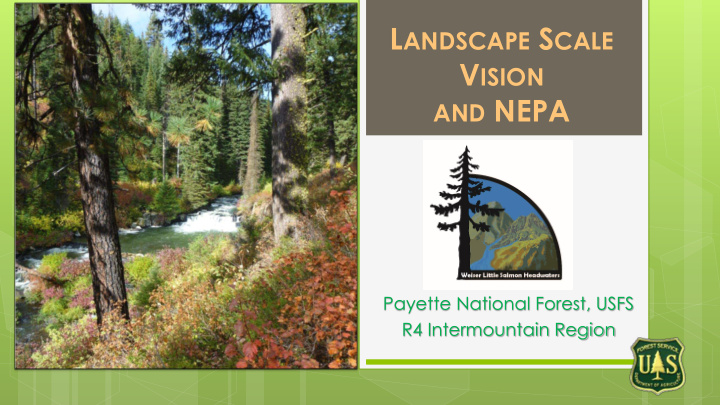



L ANDSCAPE S CALE V ISION AND NEPA Payette National Forest, USFS R4 Intermountain Region
GUIDING PRINCIPLES NEW VISION FOR NEPA – LANDSCAPE SCALE Leading Change – John P. Kotter Establishing a sense of urgency (PRIORITY) Creating the guiding coalition (COLLABORATIVES) Developing a vision and strategy Communicating the change vision and new reality Assessing what’s working (and what’s not) and developing improvement Successes integrate change in the culture
URGENCY/PRIORITY Weiser – Little Salmon Headwaters Collaborative Forest Landscape Restoration Project Landscape scale approach to managing 970,000 acres One of 10 nationally selected Collaborative Forest Restoration Programs in 2012 – receive annual funding Collaborative effort working with the Payette Forest Coalition (PFC) Provides opportunities for the Payette NF to leverage funding to increase the rate of restoration and to contribute to local job retention and creation
CLEAR VISION Weiser – Little Salmon Headwaters Collaborative Forest Landscape Restoration Project Purpose: Restore a significant portion of ponderosa pine dominated forests to historic stand structure and function Restore habitat connectivity and quality for aquatic species and improve water quality ; Restore a more natural fire interval on the landscape Increase economic activity in Adams and Valley counties through forestry biomass utilization, and natural resource jobs.
VISION/STRATEGY Lost Creek Boulder Creek Landscape Restoration Project Project area - 80,000 acres Multiple Listed species – required consultation with USFWS and NOAA fisheries Tribal Consultation - 3 separate tribes Implementation of this project will result in landscape restoration through a combination of timber harvest, prescribed fire, and recreation improvement activities that will improve watershed conditions, wildlife habitat and contribute to economy and jobs .
ENABLE ACTION NEPA and NFMA The Forest Committed to a very aggressive timeline: 1 year NFMA - data gathering, developing a proposal, working with the public, partners, and PFC Targeted field work Utilized research and models to focus needs Focused entire program of work for the District 1 year NEPA Programmatic NEPA (Conceptual) approach Project design features for implementation Transparency in process steps – many public meetings and field trips Worked collaboratively with the Payette Forest Coalition
ENABLE ACTION Lost Creek Boulder Creek Landscape Restoration Project Vegetation Management Commercial Thin - 12,200 acres • Commercial Thin/Mature Plantations - 8,100 acres • Patch Cut - 1,800 acres • Total Commercial Vegetation Treatments - 22,100 acres • Riparian Conservation Areas - 1,530 acres Total Non-commercial Thinning Treatments - 17,700 acres Prescribed fire treatments - 45,000 acres Recreation Management and Travel Management Improved dispersed campsites, vault toilet installations, major recreation • improvements, OHV trail creation, 35 miles of trail maintenance, trailhead improvement Road Management, Watershed Restoration, Fisheries Habitat Improvements Road graveling - 34 miles, Roads converted to long term closure status - 61 miles • System road decommissioning - 68 miles, Unauthorized route treatment - 117 miles • Fish passage improvements (Total) - 36 •
WHAT WORKED Success Strategies Invested time up front to explain the Forest Plan - standards, guidelines, requirements, restrictions, limitations Monthly meetings with the Payette Forest Coalition – open to the public for real time updates, presentations, field trips Explain the rationale- In presentations, meetings, documents, and decisions Subcommittees - Vegetation subcommittee met between monthly meetings to discuss desired outcomes, non-negotiables
WHAT WORKED Success Strategies Engaged Regulatory Agencies and Tribes (USFWS, NMFS) very early and throughout the process Engaged Technical Teams for threatened species to understand and propose restoration and vegetation treatment needs Stewardship Proposals - Proposals approved by the Region to include a variety of treatment and work
BUILD ON CHANGE Challenges/Opportunities “Implementation Wedge” - project design and mitigation workload Working Together - Looking at using Good NA to use Idaho Department of Lands staff for prep and layout Retained Receipts – opportunity for additional contract work for restoration Litigation – LCBC was litigated – Judge denied temporary restraining order PFC and Adams County were interveners on the Litigation
INTEGRATE CHANGE Anchoring new approaches Continue Landscape Level Projects - 50,000 acre Middle Fork Weiser River, 75,000 acre Huckleberry, 45,000 acre proposed Meadows Valley Analysis Area – identify opportunities upfront, draw project boundary after NFMA data collected, limit NEPA boundary to those areas where proposed activities would actually occur
Recommend
More recommend